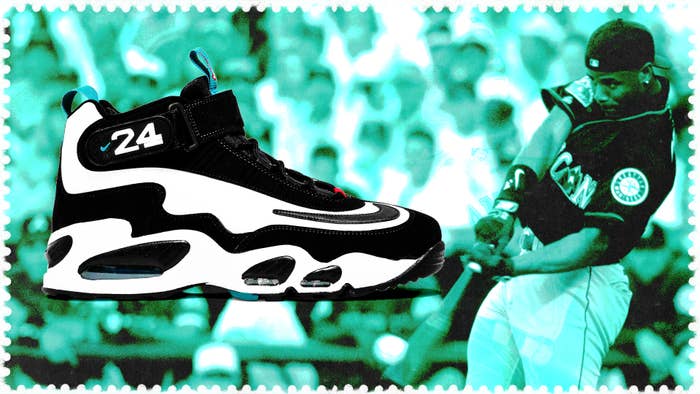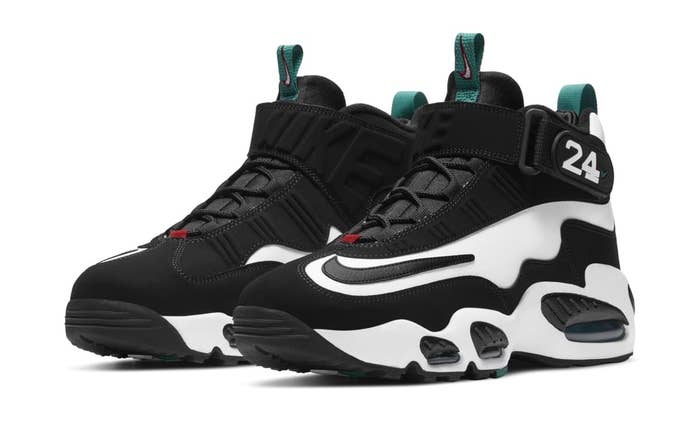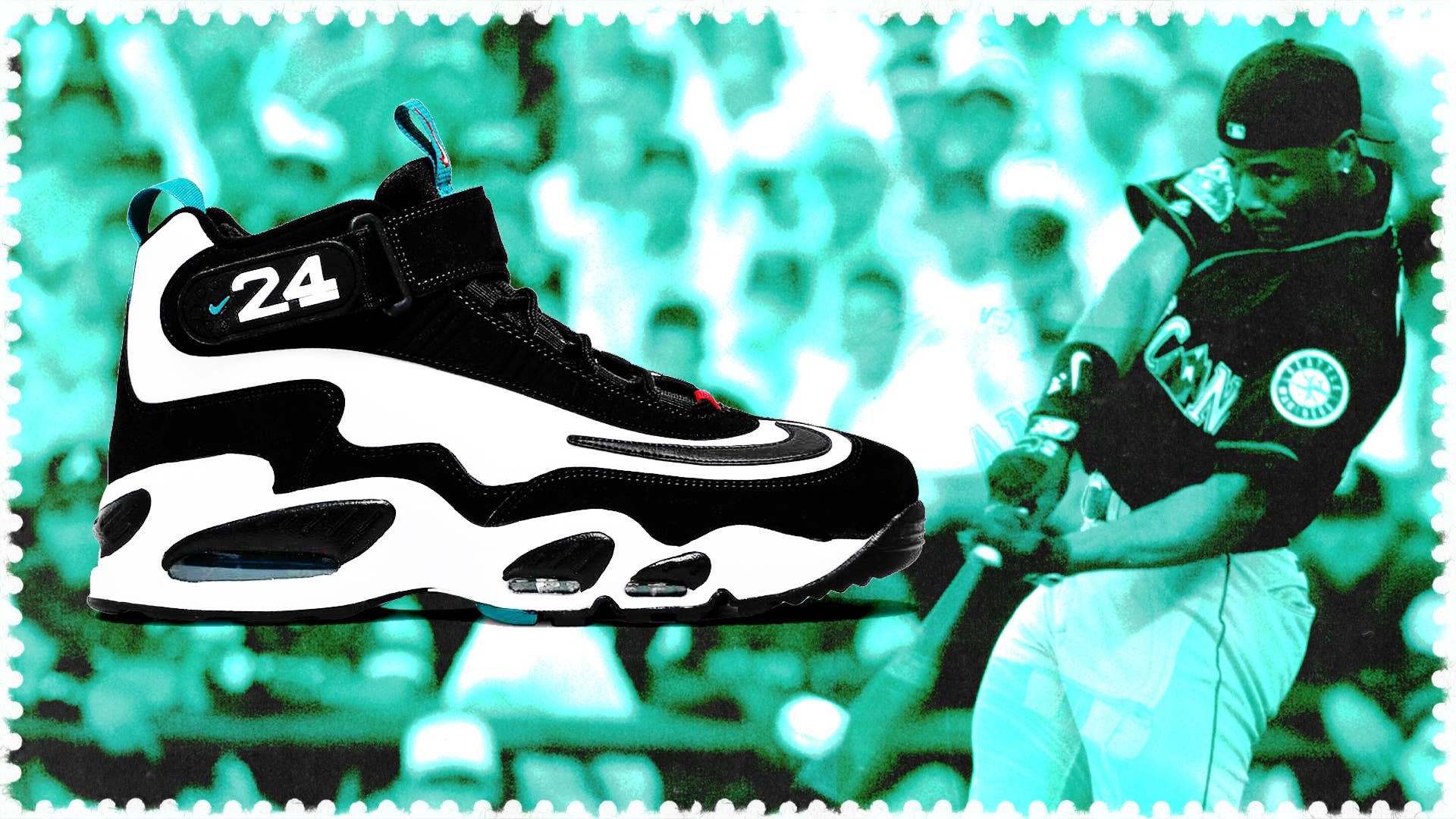
With his first signature model’s recent retro, a new generation of sneaker enthusiasts are learning about longtime Nike athlete Ken Griffey Jr. The man affectionately known as “The Kid” may have been the closest thing to Michael Jordan that baseball ever saw in terms of star power. And his sneaker line is still one of the most storied in footwear.
For Griffey, the story started on the field. As the son of a pro player, he went from number one pick in 1987 to 13-time All-Star, winner of 10 Gold Gloves, 1997 AL MVP, and the first Mariner to enter Cooperstown. Griffey had it all: skills on the field, a magnetic smile, and endless amounts of swagger. It earned him adulation from adults and kids alike.
He also had Nike powering him to megastar status with its savvy marketing.
By the mid-1990s, Griffey’s popularity was sky-high, making him the best option to succeed Bo Jackson and Deion Sanders as the face of Nike’s burgeoning Cross-Training category. The big smile and hat turned backward from a young guy playing the game with flair stood out against baseball’s stoic traditions. With his charisma and talent, Griffey added new life to the game needed.

When the time arrived for his first model, Griffey knew the main things he wanted for his shoe. “Just make it loud,” he told longtime designer Terry Teague, per a 2009 Sole Collector interview. “At that time, I wanted to be different than everybody else. I think that was the one thing that I wanted. A big ol’ Swoosh on there, too, and I wanted a strap. I think I was really adamant about the strap.”
Any shoe bearing his name needed to be a multipurpose shoe that could go from working out and batting practice to activities away from sports. He desired a shoe that could “be fashionable wearing them with jeans; I was really adamant about that.”
Teague and company delivered on all of Griffey’s asks.
Griffey’s turf-ready model arrived at a time when Jordans and Nike basketball shoes dominated the market. Initially released in 1996, the Air Griffey Max 1’s design sported an upper mixed with synthetic leather and Durabuck. An internal bootie and an adjustable ankle strap adorned with The Kid’s number 24 created a secure fit. Heel and forefoot Max Air put it on par with the tech featured in top models from other categories. The three launch colorways—the two Mariners uniform-friendly “Freshwater” colors and the more eye-popping “Varsity Royal” pair—stood out on store shelves. Not an easy task considering guys like Jordan, Charles Barkley, and Allen Iversonall had signature lines to compete against.
The choice was obvious for buyers like Patrick Sin. He moved from Hong Kong to attend college in Seattle in 1994, just as Mariners Mania took over the city. To get up to speed on his new home, he studied all things local, including the baseball team.
“All I knew at the time was to pay attention to some dude named ‘Griffey,’” says Sin, who’s known on NikeTalk and social media as SinnerP, his avatar bearing Griffey’s Swingman logo. That led him to seek out a pair of the star’s sneakers.

“My first pair of Griffeys were the O.G. Air Griffey Max 1. Bought them in ‘96, but not during launch,” he says. “I just remember walking into a Nordstrom and seeing them on display and discounted. The style/design of the shoe immediately appealed to me. Plus, the fact that the ‘local hero’ wore them.”
Griffey’s star power extended beyond the Pacific Northwest. We’re talking about a guy who once had his name appear on a candy bar and a Super Nintendo baseball game. Two of the driving forces behind his popularity were Nike and ad agency partner Wieden+Kennedy, who launched the ballplayer’s fictional run for the nation’s highest political office with the “Griffey in ‘96” ad campaign. The products took a backseat to the personality, as Griffey starred in commercials with political strategist James Carville, legendary funk musician George Clinton, Orlando Magic stars Nick Anderson and Anferenee “Penny” Hardaway, plus another Nike marketing phenom, Lil’ Penny. The hilarious ad spots won fans’ hearts with his pitch to keep the hitting game “pepper” alive and political views that didn’t lean too far left or right, landing in centerfield, making him a candidate for everyone.
The campaign left its mark on fans, including Aaron Kr., who handles design and creative for Packer Shoes and others.
“He was already an American hero in so many ways—why not a presidential run?” he says. “The inclusion of George Clinton is another perfect demonstration of Nike/Wieden+Kennedy’s knack for bringing different aspects of culture together in unexpected ways. On a similar note, the inclusion of Lil’ Penny was an amazing intra-Nike crossover that brought two of their most compelling campaigns together and showed an endearing universal front among the brand’s athletes.”
The marketing push paired with his play drove Griffey’s popularity to new levels and increased the want for his shoes. But for Kr., the design lent itself to greatness on its own merit.
“This shoe is of a time when Nike design could basically do no wrong and was one-upping themselves year after year,” he says. “They didn’t need some elaborate hype machine brainwashing you into thinking the shoes were cool. They were cool because they were just actually cool. Sure, the ad campaigns were amazing, and the athletes did their part, but people genuinely loved and appreciated this shoe and others of the era on the merits of their designs, regardless of what you knew about them or whose name was on them.”
While Griffey’s signature series stretched across several models, none of the later entries earned the admiration of the first, the Air Griffey Max 1. The model retroed for the first time in 2009 and has been re-released numerous times since then. The silhouette appeared in a slew of colorways, most of them forgettable, but still with a few that worked. A Cincinnati Reds-themed version from 2011 harkened back to his days spent there while 2016’s “Griffey for Prez” and all-white “InductKid” pairs rekindled memories and celebrated the past. Nike’s even found ways to reference the “Freshwater” color scheme for another Ohio-born endorser’s signature sneakers and his #LeBronWatch series.

Most enthusiasts regard the three original color schemes as the best versions of the Air Griffey Max 1. The colorways that Griffey wore hold more relevance than newer ones that lean heavy on hot color trends.
“My opinion on colorways is they should always retro all the O.G. colorways first, then go nuts with the various ‘experiments,’” Sin says. “I get that Nike will sometimes try some out there colorways to cater to the new generation, but most of the time, they’re a miss for me. Having said that, not all are bad. I guess I always preferred some context to colorways.”
Fans revere the Air Griffey Max 1 and its namesake for what they represent. Nike compelled us to believe in Griffey and his shoes. He embodied the quintessential athlete who wore a versatile sneaker, both of which happened to be backed by a brand whose image-making abilities were endless. “Nike did a great job of showcasing his personality, style, and culture during his playing career,” says Patty Lora, who previously worked in creative marketing for the Miami Marlins organization. “Griffey was able to dominate on TVs and on the field without ever playing for a major media town like Derek [Jeter] in New York, Barry Bonds in San Francisco, or even [Sammy] Sosa in Chicago. People admired Junior’s appeal because he remained consistent with his midwest values and dedication to the game of baseball for over 20 years.”
It’s a sentiment shared by Aaron Kr.
“Baseball hasn’t legitimately been America’s national pastime for a long time now,” he says. “Back when it still was, players like Mantle, Mays, DiMaggio, Aaron experienced god-like status and cultural ubiquity. Griffey may be the last bonafide baseball god we ever see.”
That reverence translates over to Griffey’s shoes for Kr. “Like a lot of other shoes from this era, the Griffey 1 will always have its place in sneaker history. Trends will come and go, but the classics are forever. I probably haven’t worn a pair of Griffey’s in the last 10 years, but I don’t love it any less than I did in 1996, and my collection would feel unsettlingly incomplete without it.”

